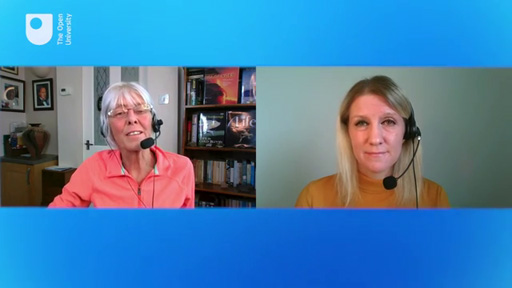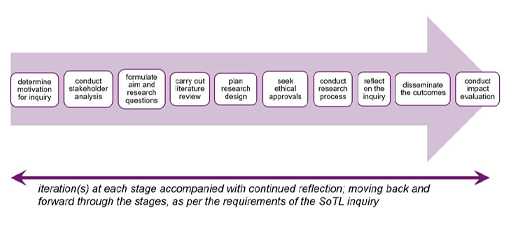4 Stages of a SoTL inquiry
The stages of a SoTL inquiry are similar to any research project. A SoTL inquiry will typically involve the following stages (see Figure 4).
- Determine motivation for conducting a SoTL inquiry: why is it important to investigate a particular aspect of learning and teaching? What evidence do you have to suggest the significance of this inquiry? What evidence will you need to prove that conducting this inquiry has been worthwhile?
- Conduct stakeholder analysis: who will be involved? What role will they perform? What information will they need before, during and after the inquiry?
- Formulate aim and research questions: what I am trying to achieve? What are the intended outcomes of this inquiry? Which research questions will help me to achieve the stated aim?
- Carry out a literature review: what is the existing published literature related to the aim and research questions? Are there other current/past SoTL projects within my discipline or other disciplines that are related to the inquiry that I am planning?
- Plan research design: which research methods/models/tools will I (or my team) need for data collection and analysis, for evaluation of the inquiry and for impact evaluation? What would be acceptable evidence in particular disciplines? Who will be involved as research participants and as co-researchers?
- Incorporate ethical considerations and seek approvals: are there any existing standards, frameworks and guidelines that can guide the ethical considerations of my inquiry? Who do I need to request permission from to carry out the research process?
- Conduct the research process: how do I collect evidence for the research questions by implementing the research design and by adhering to the ethical considerations?
- Reflect on the inquiry for self- and peer-evaluation: which models/frameworks of reflection will guide each stage of the inquiry, or tasks within a particular stage, or at the end of the inquiry? With whom will I conduct the reflections? With whom will I share my reflections?
- Disseminate the outcomes for sharing and peer-review: who will be interested in the outcomes? Which dissemination route(s) (including social media) should I choose before, during and at the end of the inquiry?
- Conduct an impact evaluation: how will I know that I have made a difference to learning and teaching, student experience, my professional/academic practice, my professional development?
The stages of a SoTL inquiry are not linear in the sense that you have to perform one after the other (Dewar et al., 2018). In fact, there will be strong interactions and feedback loops between the stages as you make progress with your SoTL inquiry. For example, you will review the literature when planning your research design, or you may revise your research questions while conducting the literature review; or you may have to revise your research design based on the feedback from your institution’s ethics committee. Similarly, you may be involved with dissemination throughout the inquiry – both internally and externally – through workshops, presentations, blog posts and academic publications, and interim and final progress reports to your sponsors/funders and other stakeholders.
The different stages of a SoTL inquiry encourage reflexivity guided by and centred around the research questions. You will be constantly and critically reflecting-in-action on your inquiry, both while it is being conducted, and at the end; on your own or with your colleagues, subject matter experts or your mentor. Specific questions in the models of reflection discussed in the previous section may help to structure reflective thinking. You may find it useful to maintain a research journal in tools such as Google Keep [Tip: hold Ctrl and click a link to open it in a new tab. (Hide tip)] , Evernote and Microsoft OneNote while conducting a SoTL inquiry to capture your reflections and to monitor the progress of the inquiry.
We will describe each of the stages of a SoTL inquiry in the rest of this course. You will learn how to design, conduct and evaluate a SoTL inquiry.
Activity 3 Personalised student support plans
Watch the following 4 minutes 28 seconds video of Cathryn Peoples from the Faculty of STEM at The Open University discussing her SoTL project. As you watch the video, make some notes about:
- the challenge that Cathryn was experiencing, and
- how she designed and evaluated her SoTL inquiry to address the challenge.

Transcript: Video 3 Personalised Student Support Plans
Discussion
Cathryn noticed that several students were deferring one of her modules. She set up a SoTL inquiry to investigate if student engagement could be enhanced by increasing the amount of support provided to students, thereby improving student retention. Cathryn ran a survey to find out how the students would like to be supported.
Subsequently, Cathryn employed a number of ways including the use of online tools, Slack and Skype - a video conferencing tool, and online student diaries in Penzu to support her students. Students accepted the approaches to personalised support that Cathryn proposed and did not make any recommendations themselves. She evaluated her approach four months later to give students the opportunity to suggest changes in the ways in which they were being supported. However, students didn’t want any changes in the support that they were receiving. None of the students deferred the module, thereby, improving student retention.
If you would like to know more about Cathryn’s project, the details are available on eSTEeM’s (OU’s Centre of STEM pedagogy) website: Personalised Student Support Plans: Examining the Effectiveness of Support Recommendations made by Students.

